The Aftermath of Us
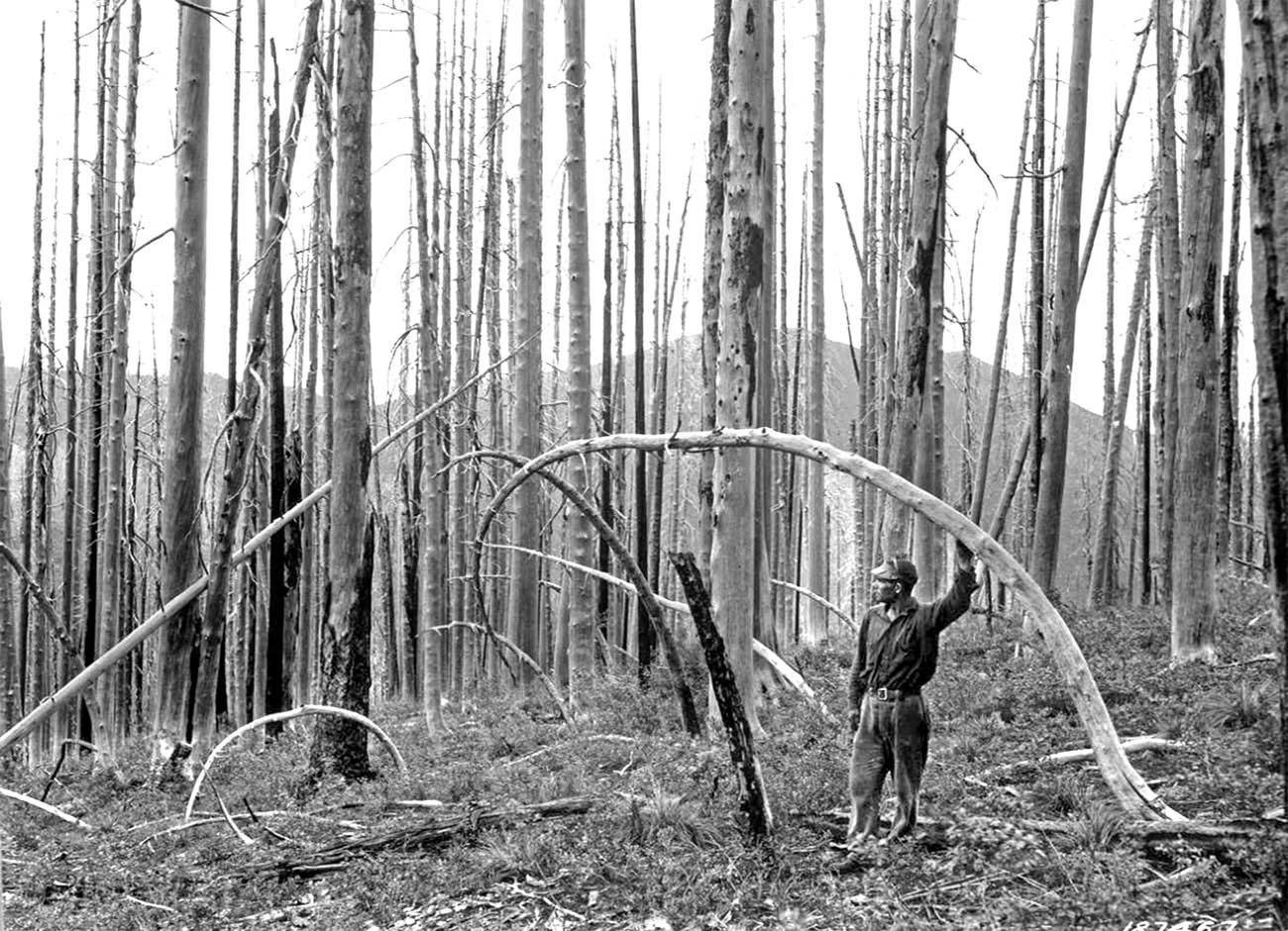
IT STARTED WITH A MISSING DATASET.
Brendan Murphy was listening to a talk about megafires in 2017 when a graph on a slide caught his attention. He tried tracking down the data about wildfires in the 20th century, but this one “mystery” dataset kept popping up instead, Murphy says tapping his laptop keyboard. “It’s pretty distressing.” He flips the screen to show a chart of wildfire acreage burned starting with a peak in 1930 and dropping precipitously through the ‘50s.
Murphy, a research associate in watershed sciences, found himself wading through conspiracy theories floated online, he says. “I just wanted to know what this dataset was, and if it was real, because it was purportedly from the U.S. Forest Service … Sure enough, I found that original data and that is how it plots out.”
It combated the narrative he kept hearing that the area burned by wildfire out West was increasing. Murphy turned to Larissa Yocom, a fire ecologist at Utah State University, and asked if she could make sense of it. The two dug into the data and found that most scientists were focused on satellite-derived records beginning in 1984 to the present. Other researchers dismissed the dataset entirely.
“I was a little bothered by that,” Murphy says. “It’s data. It may have issues, but it was still data that someone collected, and it presumably tells us something. Something meaningful.”
So, he asked Yocom, is this record real?
Rethinking fire
A framed poster “Northwest Native Conifers” decorates the wall above her desk. Lodgepole pine. Douglas fir. Jeffrey pine. Ponderosa—each evergreen etched on the page has an evolutionary strategy for living with fire.
Yocom places a sample of a tree core on the table.
“Basically, all of these little scars are from fires,” she says, pointing to a tree ring flecked with charcoal. “This tree is sort of a perfect record of fire because you know for sure that a fire burned in each of these years. Look, this tree lived through one, two, three,” she counts, “10 fires over two centuries.”
And you know the fires were low severity because the tree survived through 2009 when researchers cut a piece out with a chainsaw. The chronology of fire scorched into tree rings allows scientists to reconstruct historical conditions in a forest. It can also tell us how they have changed.
Fires in some forests used to burn in more regular return intervals, Yocom explains. These were not fast-moving fires that swept into the canopies, but flames that crept along the ground, killing saplings and the underbrush until it was snuffed out by rain or diminished fuels. Fires were nearly everywhere out west, she says, but in many places they weren’t often severe.
“The scale now—you’ve got crown fires burning through canopies for miles. That’s crazy compared to what these forests are adapted to.”
In the late 1800s, early 1900s there was a national argument about fire in American forests, Yocom says. The fires of 1910 helped to decide it.
The Big Burn of 1910 spanned three million acres across northern Idaho and Montana and tested the members of the fledgling U.S. Forest Service. Rangers tamped the inferno with shovels, axes, saws, and prayers for rain. Seventy-eight firefighters died trying to wrangle flames from engulfing the towns and timber harvests in its path. Their efforts seared fire suppression tactics into the playbook of American foresters for more than a century.
We are still living with the consequences.
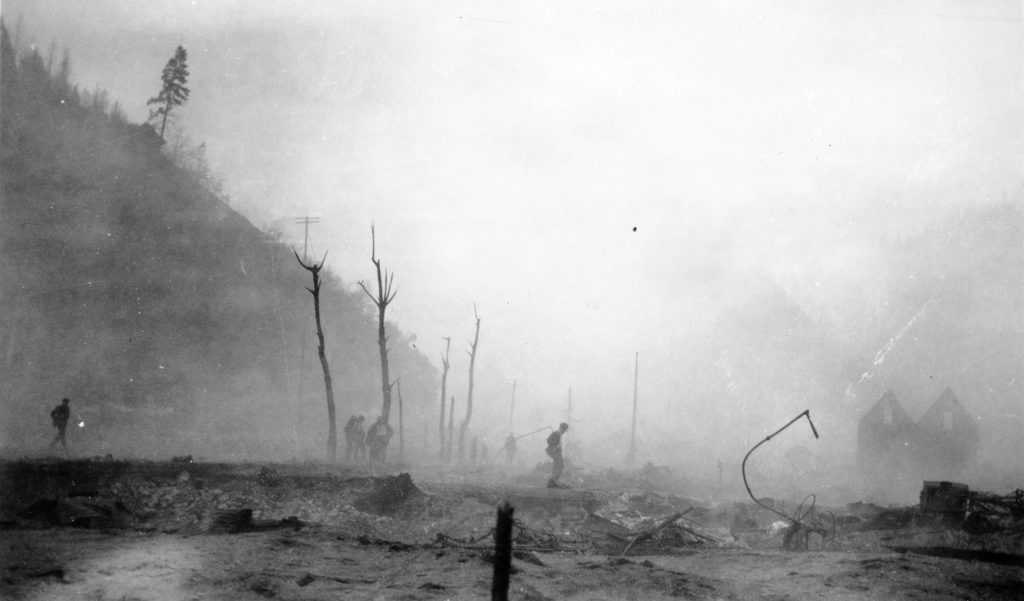
Photo courtesy of the A.B. Curtis Collection, University of Idaho Library Special Collections and Archives. Forest Fire 1910–Striped peak area.
When a forest caught fire, firefighters tried to push it back and put it down. But instead of taming fire, we unknowingly created conditions allowing it to be the worst it could become and disrupted natural systems. Climate predictions for a drier, warmer west will further spark tinder box conditions.
“We’ve got way more trees, we’ve got more fuel, and so the fires are likely bigger—the biggest ones are without a doubt much bigger,” Yocom says, citing a series of Arizona wildfires that burned nearly half a million acres or more since 2000—some with high-severity patches stretching thousands of acres. “It’s not as if no trees ever used to get killed,” Yocom says. “But the scale now—you’ve got crown fires burning through canopies for miles. That’s crazy compared to what these forests are adapted to.”
But the storyline—and solutions—are not the same across western forests. It goes back to understanding the history of a place and the species that evolved there. Some conifers, like lodgepole pines, have serotinous cones that need high heat to kickstart reproduction whereas trees like ponderosa pines evolved to withstand frequent low-severity fires on the landscape.
“Because they have different strategies and adaptations they can get screwed up in different ways,” Yocom explains.
“If fires only can burn in the most catastrophic, most extreme weather conditions, you are basically limiting fire to the worst it can be.”
Some management strategies such as thinning trees or using prescribed fires to reduce fuel loads could make fires worse in dense, moist forests because it could dry out fuels and reduce wind breaks, Yocom says. “Ecologically it doesn’t make sense—that’s not how these forests grow.”
But for other forests, think dry pine forests across southern Utah, Arizona, and Colorado, more managed fires on the landscape could be a path forward.
“If fires only can burn in the most catastrophic, most extreme weather conditions, you are basically limiting fire to the worst it can be,” Yocom says. “That’s just a really bad idea. Because everywhere will burn eventually. What people should be doing is choosing the type of fire they want to see, not whether or not they want to see fire.”
And that points to another critical factor influencing western fires—us.
“Ideally, you wouldn’t be managing fire at all—but there is so much WUI [wildland-urban interface] and the fuels are so different that we’ve created a really expensive mess,” Yocom says.
The 2010 U.S. Census revealed that more than 23 million people live on the fringes of western wildland. But most early settlers spurred westward had no idea what they were getting into.
Recalibrating Risks
“We don’t really have a good sense of wildfire,” Murphy says. “People have just built their homes in places that historically would not have been a wise place. If you moved out here and saw fires burning 10 percent of the landscape every year, you wouldn’t put your house in the woods.”
But that’s not what they saw.
The West’s population boomed after World War II, just as foresters began excelling at fire suppression, Murphy says. “That just so happens to be the same time we were getting really good at building dams.” It also coincides with a period of relative quiet in terms of wildfire on the landscape.
Now, consider that problematic dataset Murphy and Yocom dissected.
The record only tells part of the story of wildfires in the United States. It lacks the context of long-term fire records. While the acreage burned by wildfire is lower than in the past, fires today are more severe, and, in some places, getting bigger. And since the 1980s, there has been an uptick in wildfire. In other words, limited records underestimate the growing threat.
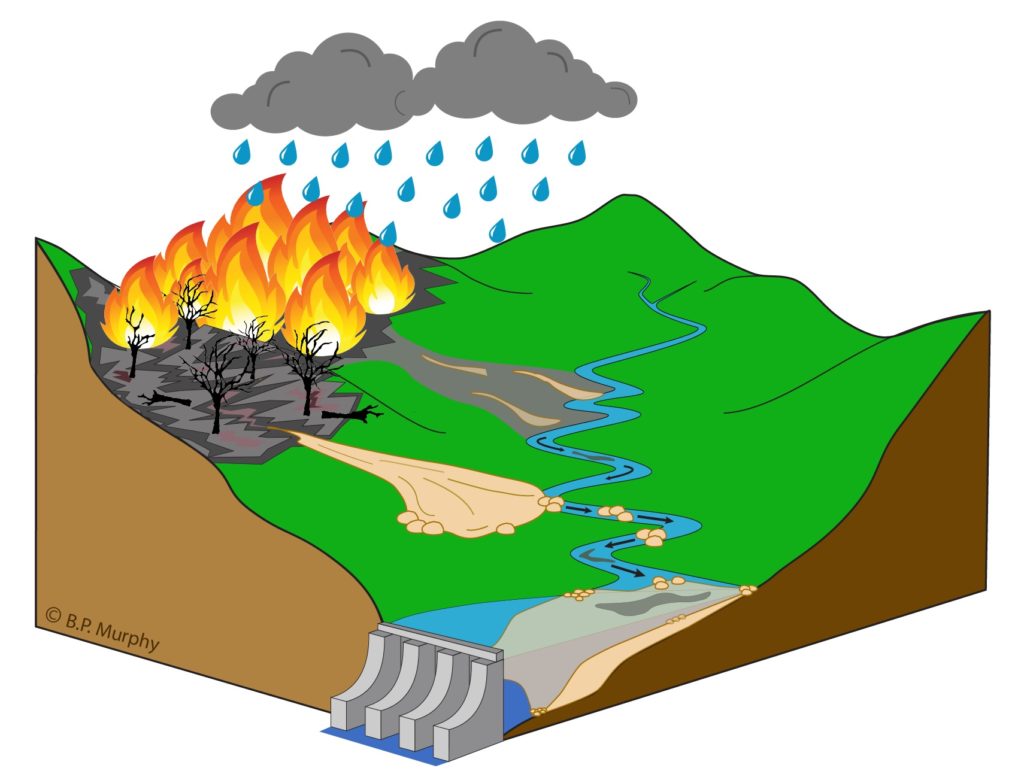
Wildfire poses risks to downstream fish populations and water resources after a high-severity burn. Rainfall can generate debris flows and erode hillsides, releasing sediment into streams. Over time, sediment collects in downstream reservoirs, resulting in potential losses to storage capacity. Graphic by Brendan Murphy.
“There is this idea of environmental amnesia,” Murphy says. “That if you didn’t live it, that you forget about it … and so you don’t take risks seriously.”
In 2018, Murphy, Yocom, and Patrick Belmont, a watershed science professor at USU, authored the paper “Beyond the 1984 Perspective: Narrow Focus on Modern Wildfire Trends Underestimates Future Risks to Water Security” to spotlight the threats wildfires pose to western rivers and reservoirs. Because the dangers from fire persist long after the last embers fade.
“When you think about the risks posed by fire poses, water is not what comes to mind—water is what puts out fire,” Murphy says.
But after a wildfire, particularly a high-severity one, the root structures holding soils and debris in place are gone. Rainfall can wash large sediment loads into streams and clog reservoirs downstream. Murphy and Belmont oversee a $480,000 National Science Foundation grant to analyze the risks to major reservoirs across Utah and recently devised a new model to estimate how much sediment from debris flows and hillslope erosion could enter downstream infrastructure.
“The sort of dirty secret of dams is that they all have a sediment lifespan,” Murphy says. “They were all designed knowing that the river flowing into it is carrying sediment.”
And over time, that sediment builds up.
Murphy and Belmont tested the model using data from Utah’s 2010 Twitchell Canyon Fire that wiped out Bonneville cutthroat trout populations in within a Blue Ribbon fishery. About 650,000 thousand cubic meters of sediment—picture a football field stacked with sediment 400 to 500 feet high—was estimated to erode after the fire, Murphy says. Simulations showed that after seven years, the majority of sediment was stored within the watershed with just two percent accumulating downstream. Good news, right?
“The sort of dirty secret of dams is that they all have a sediment lifespan.”
It depends on the storage capacity of downstream reservoirs, says Murphy. “If it was Glen Canyon Dam that was at the base then you’re probably fine, but if it’s these moderate-sized reservoirs that we have throughout Utah, they could be at serious risk.”
For example, that same two percent of sediment could erase 22 years of sediment capacity in Logan’s First Dam reservoir. With wildfire and sediment yields predicted to increase, the West could be on a collision course with reservoir storage.
“In the worst-case scenario, you could have catastrophic losses where with the right wildfire in the right place with the right reservoir, you could lose the entire reservoir,” Murphy says. “That’s not conjecture and fear mongering, that’s a real risk and has already occurred in places like Denver, Colorado.”
After the 2002 Hayman Fire, Colorado water companies spent at least $23 million to dredge a reservoir deemed too important to lose. That’s one expensive approach to dealing with sediment, Murphy says. Another way, he says, is to allow “more fire on the landscape where it can happen in a more moderate way.”
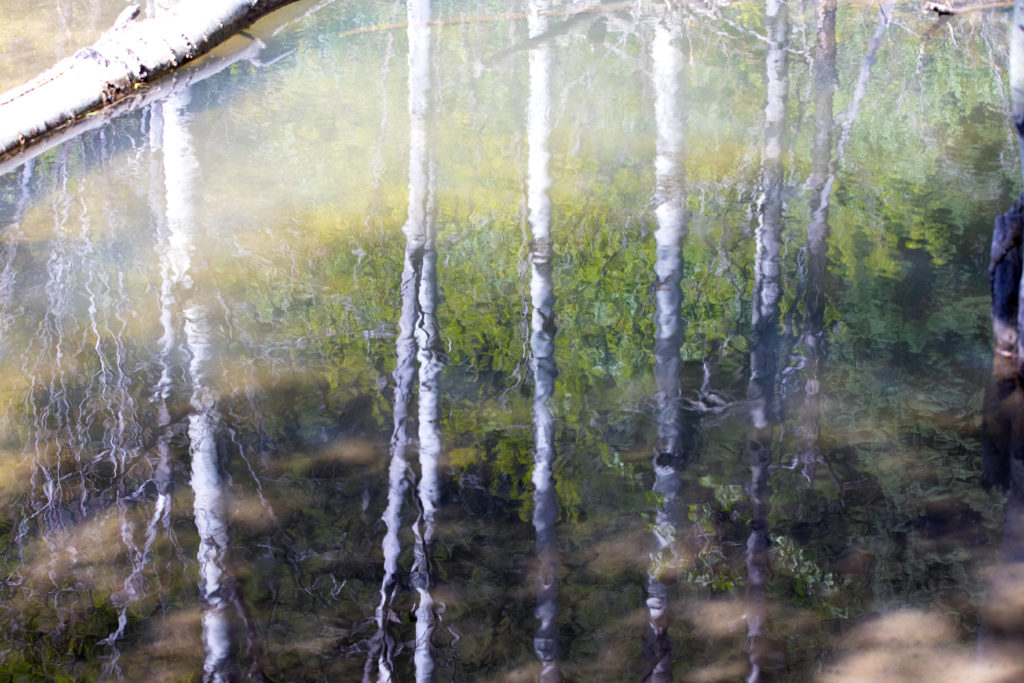
Aspen stems reflected in a dammed portion of Birch Creek in Preston, Idaho.
This summer, Yocom, Murphy, and Belmont submitted a proposal to the Joint Fire Science Program to study how traditional fuel treatments such as thinning and prescribed burns could reduce risks to watersheds, as well as a third method Yocom is investigating: aspen. Most firefighters will tell you that aspen knocks down fire, she says. Could aspen act as a natural firebreak?
And what if there is an additional, furrier way to increase resiliency in western watersheds?
Rethinking beaver
The early waterways of North America were vastly different from today.
“They were cluttered,” says Joe Wheaton, a fluvial geomorphologist at USU. “Messy.”
That’s because the continent’s largest rodent did what beavers do across millions of miles waterways: build dams. They clogged creeks, trapping sediment in basins causing water to pool and spread across floodplains. An artifact of beaver home building is the expansion of riparian corridors that create more complex, more resilient habitat and protect wildlife during forest fires.
“It’s not rocket science,” Wheaton says. “Water doesn’t burn.”
However, beaver populations were decimated in the 1700 to 1800s as European fashion demanded their pelts for hats. Estimates suggest as many as 400 million beavers once crowded waterways across the United States. A tiny fraction of the figure exists today. Wheaton argues adding beavers to the landscape could improve the nearly “one million miles of perennial waterways out West that could use some love.”
“It’s not rocket science. Water doesn’t burn.”
He holds up a sticker reading: “Process based restoration low-tech.”
Humankind has excelled at dam building and moving water quickly and efficiently through forests into developed areas. We’ve winnowed valley bottoms so that water moves like a highway, Wheaton, says. Allowing streams and rivers to return to a more natural state is an inexpensive way to restore waterways on a larger scale. We can even jumpstart the process without beaver.
While Wheaton worked on water restoration projects with researchers Nick Bouwes and Michael Pollack, they noticed that post-fire habitat recovery was accelerated when beaver were present. We were not the first researchers to recognize this, Wheaton insists. In the 1950s, the Forest Service air dropped beavers into riparian zones in Idaho.
“These ideas go way back,” he says. “We forget.”
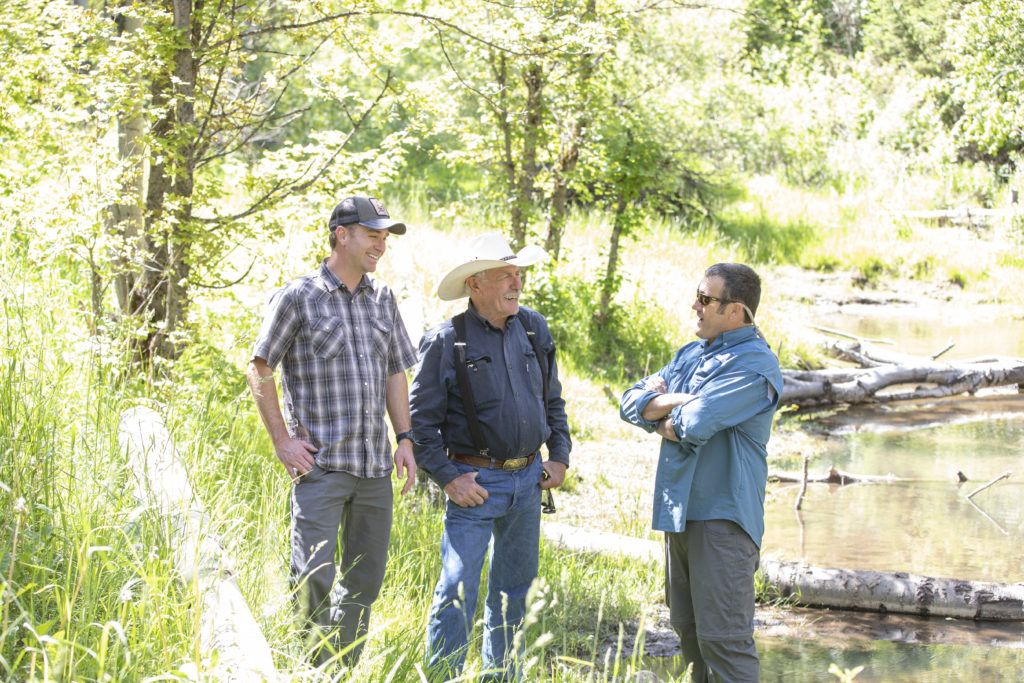
Joe Wheaton, Jay Wilde, and Nick Bouwes inspect the BDAs erected on Wilde’s property. Wilde is co-authoring a scientific paper about the restoration project with USU researchers.
Restoring processes
About a decade ago, Jay Wilde changed how he ranched after he discovered high intensity grazing restored some native grasses. Around the same time, he noted changes in the once perennial flowing stream on his Preston, Idaho property. It was drying up in mid-June. Wilde took measurements and snapped photos. He puzzled about the cause. Were cottonwoods sucking the streambed dry? Were the losses due to evaporation? One morning at the kitchen table it dawned on him.
“We didn’t have any beaver,” he says. “We didn’t like beavers back then—no one did.”
Wilde changed his mind after researching beaver. “The more I looked into it, the more it made sense—we have to have beaver in the watershed, not just for the water, but for the habitat they preserve.” He tried introducing beaver on his land twice. Both efforts failed.
In 2014, he came across a news story in which Wheaton described the benefits of beaver. Wilde searched the USU directory and zipped off an email. Within weeks, Wheaton had a pilot project of four beaver dam analogs (BDAs)—manmade structures latticed with logs and sticks to mimic beaver dams—installed on Wilde’s land as a demonstration project to show that the simple structures could create a habitat where beaver could thrive. They added 19 more BDAs and nine beaver to the landscape the following year. Because as Wilde had learned, simply releasing beavers on the land doesn’t always work.
“It was about us trying to create refuge so the beavers aren’t floating hotdogs for mountain lions,” says Nick Bouwes, assistant professor of watershed sciences, while steering his pickup north along I-89 past irrigated fields with hillsides turning gold.
Beaver are often considered a nuisance species. Which is true. Their proclivity for dam building can gum up canals and flood nearby roadways. But beaver activities may also buffer the effects of hotter, drier summers. Their presence is not always a black and white issue, Wheaton says.
His lab recently modeled 100,000 miles of Idaho waterways to determine how many beaver dams could be supported in the region and identify problematic sites, Wheaton says. “It’s kind of a broad-brush planning tool.”
“The more I looked into it, the more it made sense—we have to have beaver in the watershed, not just for the water, but for the habitat they preserve.”
Just in Utah’s 15,000 miles of streams, you can fit, 250,000 beaver dams, he says. “We are about one percent of that capacity. Historically we estimate it to be about 350,000 beaver dams that could have been supported.” The model maps proximity to roads and trails—land uses where there could be beaver-human conflict—and tries to identify where we have capacity for dam building, Wheaton explains. “That is really helpful for building people’s confidence.”
Getting Jay to tell his story also gives people the confidence to break from nostalgia, Wheaton says. Wilde regularly speaks at conferences about the impact of beaver on his land. Five years into the project about 130 beaver made dams clog his childhood stream. Wilde couldn’t be happier about it.
“Cows need two things: something to eat and something to drink,” he says, thumbing the black suspenders holding his Wranglers in place, a toothpick propped between his teeth. “You have to have water in these pastures.”
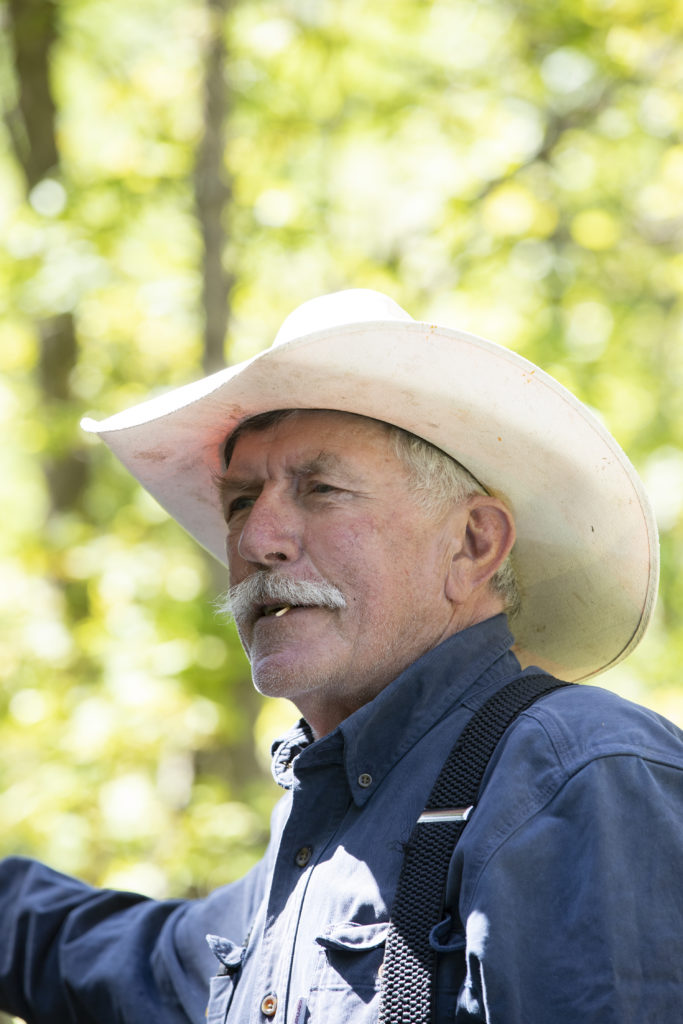
Rancher Jay Wilde tried installing beaver in his watershed years ago. After connecting with USU researchers, beaver are thriving on his land.
Beaver dams stop up streams and fan water across a floodplain. They saturate the water table at higher elevations and perform a similar function as snowpack, says Bouwes, Ph.D ’98.
“There is a lot of water storage here,” he says, hiking up a decommissioned Forest Service road to inspect the BDA on Wilde’s land. “We are only seeing part of it. The rest of it is underground. And that water trickles out in the summer.”
Projections indicate Wilde’s stream will have 25 days of additional water this year.
Wilde studies a beaver dam that appeared on the site two years ago. A small trout zips between fallen aspen trees.
“The beaver keep building up and spreading out and activating these side channels,” he says, pointing across the creek. The biggest changes he’s noticed since the project began, Wilde says, is the increased presence of Bonneville cutthroat trout.
Wheaton smiles. “The soundscape is different.”
Before the flow was uniform, he says. As the beavers blockaded the stream they altered its flow speeds. The forest sounds different.
Wheaton points to the team’s first postless BDA erected after taking design cues from the furry engineers. This means crews don’t have to haul heavy equipment into remote areas. “This opens up so much more territory,” Wheaton says.
This also bodes well for Wheaton’s mission to quickly improve eroded western waterways on a larger scale since BDAs are about one tenth the cost per mile than traditional restoration techniques.
“It is fun to see what we can do to kick things off,” Wheaton says, but, he adds, it comes back to respecting the process, which means letting nature take over.






USU Editor September 24, 2019
Hi Curtis,
You bring up an interesting point on Cheatgrass. While I’ve been wondering about its impact on western landscapes – fire intensity wasn’t initially in my head. Thank you for bringing it up!
Best,
Kristen
Curtis McCarthy September 23, 2019
Good article focused around fires and water management. My first thoughts regarding the change of fire intensity in the west made me think of the problems caused by Cheatgrass and how that has changed fire timing in the western environment. It is so invasive and is extremely explosive and changes fire intensity. Traveling through western Utah you see its purple presence in vast tracts a lot more than I did forty years ago. I appreciate the information on the dams filling with silt and the possible cure is mini-dams and beaver introduction.